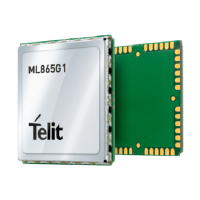2.2.4. Command Response Time-Out
Every command issued to the Telit modules returns a result response, if response codes are enabled (default).
The time needed to process the given command and return the response varies, depending on the command
type. Commands that do not interact with the SIM or the network, and only involve internal setups or readings,
have an immediate response. Commands that interact with the SIM or the network could take many seconds to
send a response, depending on SIM configuration (e.g., number of contacts stored in the phonebook, number
of stored SMS), or on the network the command may interact with.
2.2.5. Command Issuing Timing
The chain Command -> Response shall always be respected, and a new command must not be issued before
the module has terminated all the sending of its response result code (whatever it may be).
This applies especially to applications that "sense" the OK text and therefore may send the next command
before the complete code <CR><LF>OK<CR><LF> is sent by the module.
It is advisable anyway to wait for at least 20ms between the end of the reception of the response and the issue
of the next AT command.
If the response codes are disabled and therefore the module does not report any response to the command,
then at least the 20ms pause time shall be respected.
Storage
2.3.1. Factory Profile and User Profiles
The Telit wireless modules store the values, set by several commands, in the internal nonvolatile memory
(NVM), allowing to remember this setting even after power off. In the NVM, these values are set either as
factory profile or as user profiles. There are two customizable user profiles and one factory profile in the NVM
of the device: by default, the device will start with user profile 0 equal to factory profile.
For backward compatibility, each profile is divided into two sections, one base section which was historically
the one that was saved and restored in early releases of code, and the extended section which includes all the
remaining values.
The &W command is used to save the current values of both sections of profiles into the NVM user profile.
Commands &Y and &P are both used to set the profile to be loaded at startup. &Y instructs the device to load
at startup only the base section. &P instructs the device to load at startup the full profile: base + extended
sections.
The &F command resets to factory profile values only the command of the base section of profile, while the
&F1 resets to factory profile values the full set of base + extended section commands.
The values set by other commands are stored in NVM outside the profile: some of them are stored always,
without issuing any &W, some other are stored issuing specific commands (+CSAS, #SLEDSAV, #SKTSAV,
#ESAV); all these values are read at power-up.
In this document, each AT command description begins with a "AT Command short overview table" having the
following format:

